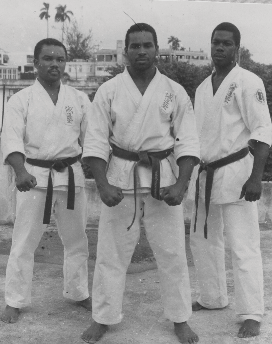|
Seido Jamaica Anual camp and schedule
New Article 'FALLING HARD' by Kyoshi Ronald

The World Seido Karate Organization officially opened its headquarters on October 15, 1976, in New York City. It is a worldwide
organization, with thriving branches in such diverse places as Australia, New Zealand, the Republic of South Africa, England,
and South America. However, within Seido, growth of the branches has not been pursued for its own sake; quality of instruction
and of the students is paramount.
Seido Juku Karate is - in concept and in practice - based on a deep understanding of the spiritual aspect of karate, which
is why Kaicho calls Seido Karate Ningen Karate or the Human Face of Karate.
In this new karate system, Kaicho Nakamura changed many of the traditional elements of karate, turning it into a martial
art for everyone, not just the physically elite.
|

|
| Jun Shihan Tony Robinson, Chief Instructor Seido Jamaica |
|
|
| Mid 90s. Jun Shihan George |

|
| Kyoshi Ron (L) and Senpai Junia (R) |
|
|
| |
|
|
| Lamorna Mid 90s |

|
|
|
|
|
|
| Jun Shihan George in 90s photo while in training for possible Japan tournament call up |
INTRODUCTION TO SEIDO MANDEVILLE
The establishment
of Seido in Mandeville had an
interesting beginning. Starting with some of our
students who had at that time been
training in
another Japanese martial art, Goju Ryu. Their
school was back then instructed by their
teacher, Sensei
Jim Lilly. When difficulties
arouse, the enthusiastic students sought another
system. Kyokushin karate, being of the
same
rough and tumble philosophy that they were used
to, was the obvious choice.
Sensei Errol Lyn was contacted
and students
arrived at headquarters for Sensei to have
discussions and evaluate for himself. The change
over
was agreed upon and Senpai Philip Houson
was appointed Sensei. Then it was the long hard
journey building the class
from the ground up in
an unfamiliar style. Later on in 1976 the switch
was made to Seido Juku, following the move
made by Kaicho Nakamura and other dojos
worldwide.
Some students training at this time familiar to
us were,
Kyoshi Vernon Williams, (now chief
instructor for Seido in St. Ann) Senpai Norman
Russell, (now abroad) Senpai Neville
'Pee Wee'
Forbes, and of course Jun Shihan George
McFarlane.
Students of the day tell of their nervousness,
or
should we say fright, when Sensei Lyn and
company arrived for the first time in Mandeville.
"You have to understand
that we had never
seen a shodan (much less a senior black belt)
other than Sensei Lilly."
"And then to see all
these major practitioners
converge on the dojo at once,,, well it was enough
to make some shiver in their gis."
Seido
in Mandeville was thus born and soon
started growing. But nothing develops without
some teething pains and hard times
were just
around the corner. There were times when class
attendance was at a premium and for weeks few
would grace
the dojo floor. However with the back bone
still active and showing that old Seido
spirit, it was not long before
things would return
to normal.
Our first dojo was at the church teachers
collage, later moving to Timber Trail
and then
Manchester High School. There at M.H.S. many
an inspirational class was held. But alas
conditions were
less than ideal. Students (of
M.H.S.) would traverse the environs for hours
daily, and most times dusty and dirty
conditions
were what greeted us on arrival.
Mandeville to say the least was noticeably
different to the other
dojos, their gis
permanently stained to a different hue.
By this time Jun Shihan George had officially taken
over
the running of the dojo. We shared the
building with Jun Shihan's gym, first at Mandeville
plaza, and afterward to
Caledonia Mall, our
present location. Pride in the Dojo naturally grew
considerably compared to those early days of
soiled gis and locked doors.
Throughout all this Seido Mandeville has had
branches in as diverse places as Christiana,
Santa Cruz and Cedar Grove.
We continue to look toward the future keeping
the tenets of Seido Karate close
at hand, and
we feel proud to have as valued and legendary an
instructor as Jun Shihan George Mcfarlane guiding us
from the front.
|
|
The main difference between students of the 70s and 80s and the present was this incredible
thirst for knowledge that was present in all who were training at the time.
That same hunger never leaves you, and
the special ones are able to translate that to their daily lives. It is no coincidence that some of our still training seniors
are of that ilk. The years but a faint memory to some, but as vivid and clear an image to others as if burned undeniably into
their psyche.
|